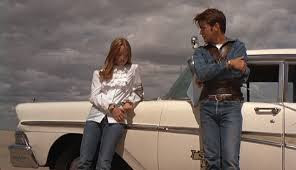Badlands
I have
never been a fan of the touring criminals genre. Intellectually I understand
that this is the ultimate freedom dream, to go anywhere you want and do
anything you want, no limits, but I do not feel that fascination and without that
there is just not that much left. Killing and stealing left and right just does
not feel that cool.
I also do
not care that much for movies about white trash. That is probably a very
arrogant and ignorant position and I sincerely apologize, but I do not even
want to relate.
White trash
on a killing tour then… well, with that premise we start at a very low point
indeed.
Yet, “Badland”
is touted as a great and classic movie so either there are a lot of people who
think differently from me or there is something else to this movie.
Kit (Martin
Sheen) is a young man in some South Dakotan town who pics up (and quickly lose)
random jobs. While being a garbage collector he meets the 15 year old Holly
(Sissy Spacek) and wants to get to know her. Neither of them say or do much
that is worth listening to and them hanging out together seems more like a
thing to do because they are bored and cannot think of a reason not to. Holly’s
father does not approve so Kit breaks into the house, packs a suitcase for
Holly and shoots her father, right in front of Holly. You would think Holly
would be screaming and shouting but she seems mostly indifferent and so they
set the house on fire and leave.
They build
themselves some fantasy treehouse, but eventually have to move one. Wherever they
go Kit uses his guns to remove obstacles and Holly never seems to question the
sense of it. Eventually, Holly does not care to continue and Kit gets caught
and that is about it.
These two
youngsters appear as complete morons, but I think it is more correct to say
that they live in an alternate reality where what they do is completely okay. Kit
likes to think of himself as a James Dean character and that he has great things
waiting for him. Holly seems to live in some childishly innocent dream world
and both of them are completely numb to the suffering they are causing.
My guess is
that the “greatness” of this movie is somehow in the portrait of these two,
although I have some trouble figuring out what that is.
One thing
that really works though is the photography. Every single picture is knife-sharp
and saturated in color. The images are staged like Sergio Leone’s and the great
emptiness of the High Plain is perfectly captured. Probably an analogy to the feral
emptiness of Kit and Holly.
There is a
stark beauty which is in contrast to the insensitive characters that makes the
film itself feel like a poem. As if in their heads they are aspiring to a
beautiful dreamlike world and in the disconnect from the real world they have
grown insensitive to it.
I am not
certain this at all makes sense.
As much as
it tries though, to me this is still a movie about white trash on a killing
tour. In a nice wrapping, yes, but I cannot get much beyond that.
Still,
there are plenty of fans of the genre and I will leave this movie to them.



